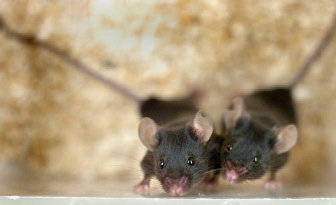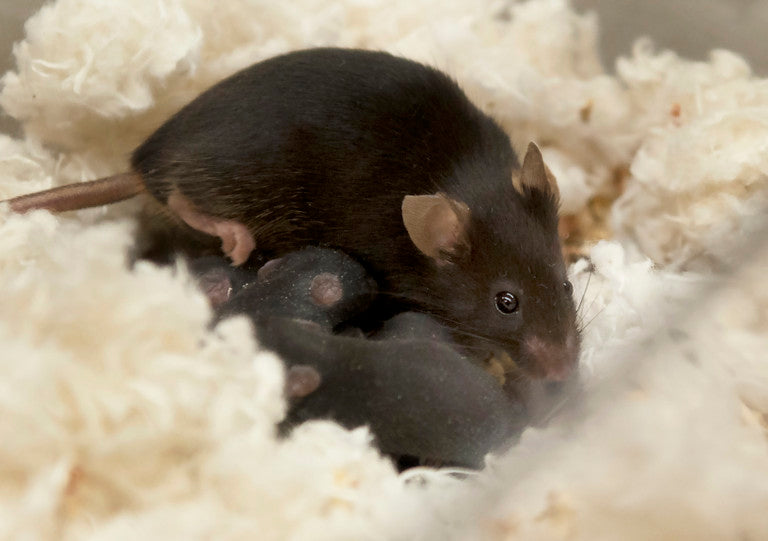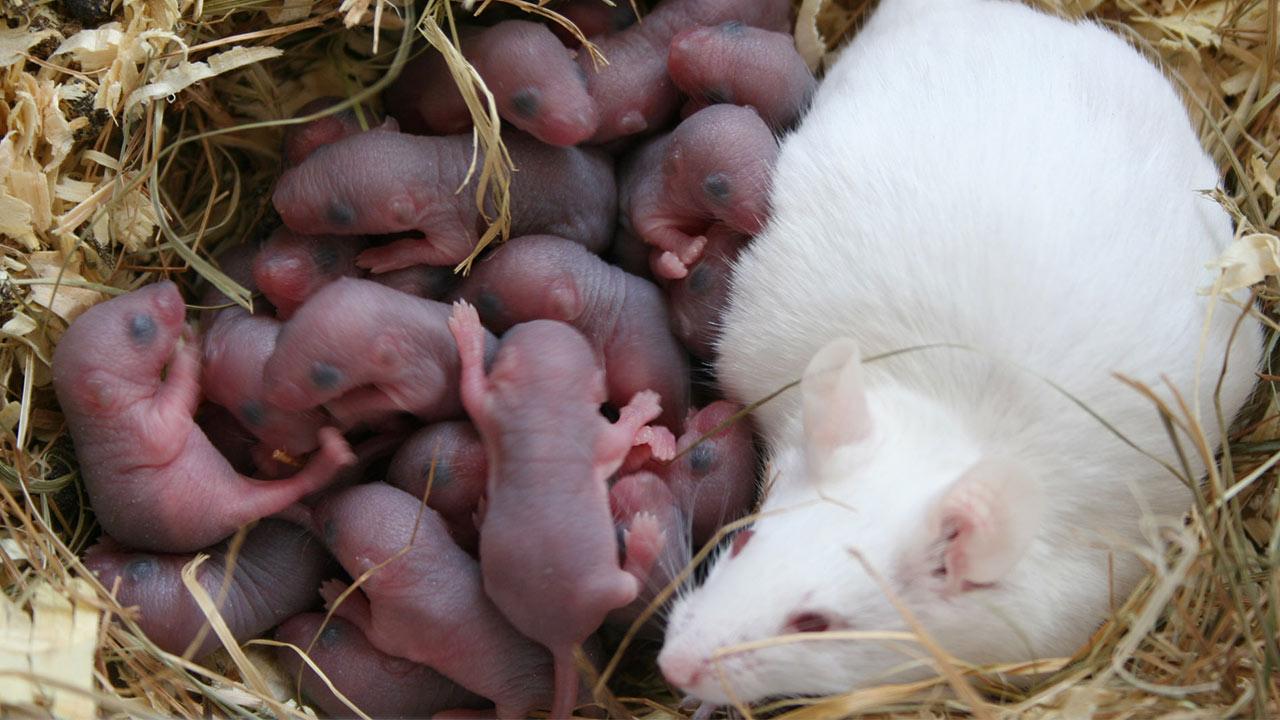The mouse estrus cycle is very short, typically repeating every 4-5 days long and consists of 4 stages:
Identifying the stage of estrous in which the females are can be useful when a specific embryo stage or times delivery date is needed for the study. With some practice, you should be able to determine in which phase of the cycle a female is by visual inspection (2). Picking the females that are more likely to mate when paired with a male will help in producing a successful timed pregnancy (3).
Three effects can interfere with the estrus cycle, and will help you achieve more predictable and successful pregnancies:
In the wild, some mammals suspend their cycle for a period during the winter; the reproductive organs are in a state of quiescence, called anestrus. Anestrus is associated with low levels of gonadotropins (LH and FSH), estrogen and progestin, with six fold higher prolactin levels, and atrophied ovaries. In the lab, mature females become anestrus or exhibit a suppressed or prolonged estrus cycle if they are housed together as a group of females. This effect appears to be olfactory though chemosignals, but the physiological mechanism of this pheromonal communication is still subject to controversy (4).
Interestingly, a similar phenomenon has been described in humans, called the menstrual synchrony or the McClintock effect, where women living more than 3 months together will synchronize their cycle within 4 days of each other’s.
Subsequent exposure of these grouped females to a male, or to urine soiled bedding from a male’s cage, results in synchronization of the estrus cycles of those females. The cycling starts in unison: about half of the females will be in estrus and receptive to mating within three days after the introduction of male pheromones (5). The length of time between pairing and insemination is strongly dependent upon housing conditions of the female prior to pairing. By using the Lee-Boot and Whitten effects, you will produce a higher percentage of females becoming pregnant, making it easier to generate a cohort of aged-matched embryos or pups.
During the preimplantation period (first 4 days of pregnancy), introduction of a foreign male or his scent will result in spontaneous abortion or pregnancy block, followed by a return to estrus in 90% of females (6). Females are more likely to block implantation when they are exposed to an unfamiliar male from a different strain, or from a different MHC than the parental male. This effect is thought to be a counterstrategy from anticipated infanticide by the non-parental males, to reduce the energetic investment by the females.
Two other phenomenon are worth mentioning here :
It is also important to keep in mind that mice have a fertile postpartum estrus that occurs 14 to 24 hours following parturition, after which they will go into anestrus until weaning. Taking advantage of the post-partum estrus by leaving the parental male in the breeding cage at all times will result in faster production of pups for studies or expansion of the colony.
For more information on breeding colony management, download our Best Practices for Rodent Colony Planning, Breeding Support, and Pup Health Guide. To try our products first hand, Request a Sample.
(1) Biology of the Laboratory Mouse, chapter 11 Reproduction, Bronson, Dagg and Snell 1966
(2) 6 steps for setting up times pregnant mice Jim Yeadon
(3) Mouse Estrous Cycle Identification Tool and Images, Byers et al., PLos One 2012
(4) Role of the Adrenal Gland and Adrenal-Mediated Chemosignals in Suppression of Estrus in the House Mouse: The Lee-Boot Effect Revisited, Ma et al., Biology of Reproduction, 1998
(5) The Laboratory Rat - Reproduction and Breeding, Lohmiller and Swing 2006
(6) The Bruce effect revisited: is pregnancy termination in female rodents an adaptation to ensure breeding success after male turnover in low densities? Eccard et al., 2017
(7) The Role of Pheromonal Responses in Rodent Behavior: Future Directions for the Development of Laboratory Protocols Bind et al., 2013 J Am Assoc Lab Anim Sci.
- Proestrus (pre-ovulation and active growth)
- Estrus (period of receptivity or “heat” and ovulation lasting about 12-15 hours)
- Metestrus (degenerative changes)
- Diestrus (quiescence or slow growth) (1).
Identifying the stage of estrous in which the females are can be useful when a specific embryo stage or times delivery date is needed for the study. With some practice, you should be able to determine in which phase of the cycle a female is by visual inspection (2). Picking the females that are more likely to mate when paired with a male will help in producing a successful timed pregnancy (3).
Three effects can interfere with the estrus cycle, and will help you achieve more predictable and successful pregnancies:
Lee-Boot Effect
In the wild, some mammals suspend their cycle for a period during the winter; the reproductive organs are in a state of quiescence, called anestrus. Anestrus is associated with low levels of gonadotropins (LH and FSH), estrogen and progestin, with six fold higher prolactin levels, and atrophied ovaries. In the lab, mature females become anestrus or exhibit a suppressed or prolonged estrus cycle if they are housed together as a group of females. This effect appears to be olfactory though chemosignals, but the physiological mechanism of this pheromonal communication is still subject to controversy (4).
Interestingly, a similar phenomenon has been described in humans, called the menstrual synchrony or the McClintock effect, where women living more than 3 months together will synchronize their cycle within 4 days of each other’s.
Whitten Effect
Subsequent exposure of these grouped females to a male, or to urine soiled bedding from a male’s cage, results in synchronization of the estrus cycles of those females. The cycling starts in unison: about half of the females will be in estrus and receptive to mating within three days after the introduction of male pheromones (5). The length of time between pairing and insemination is strongly dependent upon housing conditions of the female prior to pairing. By using the Lee-Boot and Whitten effects, you will produce a higher percentage of females becoming pregnant, making it easier to generate a cohort of aged-matched embryos or pups.
Bruce Effect
During the preimplantation period (first 4 days of pregnancy), introduction of a foreign male or his scent will result in spontaneous abortion or pregnancy block, followed by a return to estrus in 90% of females (6). Females are more likely to block implantation when they are exposed to an unfamiliar male from a different strain, or from a different MHC than the parental male. This effect is thought to be a counterstrategy from anticipated infanticide by the non-parental males, to reduce the energetic investment by the females.
Additional Effects
Two other phenomenon are worth mentioning here :
- the Vandenbergh effect in which the exposure of prebubescent female by a stud male urine pheromone will accelerate puberty and induce the first estrus;
- the Hoover and Drickamer effect in which exposure of a mature female to urine / pheromone from pregnant or lactating females will lead to a prolonged estrus (7).
It is also important to keep in mind that mice have a fertile postpartum estrus that occurs 14 to 24 hours following parturition, after which they will go into anestrus until weaning. Taking advantage of the post-partum estrus by leaving the parental male in the breeding cage at all times will result in faster production of pups for studies or expansion of the colony.
For more information on breeding colony management, download our Best Practices for Rodent Colony Planning, Breeding Support, and Pup Health Guide. To try our products first hand, Request a Sample.
References
(1) Biology of the Laboratory Mouse, chapter 11 Reproduction, Bronson, Dagg and Snell 1966
(2) 6 steps for setting up times pregnant mice Jim Yeadon
(3) Mouse Estrous Cycle Identification Tool and Images, Byers et al., PLos One 2012
(4) Role of the Adrenal Gland and Adrenal-Mediated Chemosignals in Suppression of Estrus in the House Mouse: The Lee-Boot Effect Revisited, Ma et al., Biology of Reproduction, 1998
(5) The Laboratory Rat - Reproduction and Breeding, Lohmiller and Swing 2006
(6) The Bruce effect revisited: is pregnancy termination in female rodents an adaptation to ensure breeding success after male turnover in low densities? Eccard et al., 2017
(7) The Role of Pheromonal Responses in Rodent Behavior: Future Directions for the Development of Laboratory Protocols Bind et al., 2013 J Am Assoc Lab Anim Sci.




Leave a comment
All comments are moderated before being published.
This site is protected by hCaptcha and the hCaptcha Privacy Policy and Terms of Service apply.